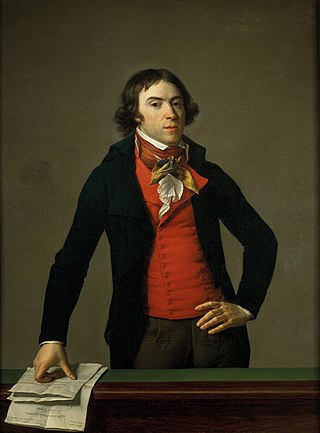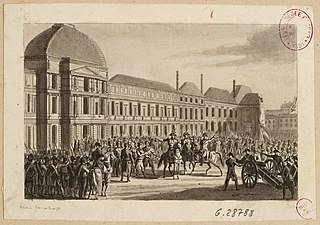See also
- Committee of Safety (disambiguation), the name for several groups throughout history
Committee of Public Safety was an organization during the French Revolution.
Committee of Public Safety may also refer to:
Commentary or commentaries may refer to:

In the history of France, the First Republic, sometimes referred to in historiography as Revolutionary France, and officially the French Republic, was founded on 21 September 1792 during the French Revolution. The First Republic lasted until the declaration of the First Empire on 18 May 1804 under Napoléon Bonaparte, although the form of government changed several times.

Bertrand Barère de Vieuzac was a French politician, freemason, journalist, and one of the most prominent members of the National Convention, representing the Plain during the French Revolution. The Plain was dominated by the radical Montagnards and Barère as one of their leaders supported the foundation of the Committee of Public Safety in April and of a sans-culottes army in September 1793. According to Francois Buzot, Barère was responsible for the Reign of Terror, like Robespierre and Louis de Saint-Just. In spring 1794 and after the Festival of the Supreme Being, he became an opponent of Maximilien Robespierre and joined the coup, leading to his downfall.

Georges Jacques Danton was a leading figure in the French Revolution. A modest and unknown lawyer on the eve of the Revolution, Danton became a famous orator of the Cordeliers Club and was raised to governmental responsibilities as the French Minister of Justice following the fall of the monarchy on the tenth of August 1792, and was allegedly responsible for inciting the September Massacres. He was tasked by the National Convention to intervene in the military conquest of Belgium led by French General Dumouriez. And in the Spring of 1793, he supported the foundation of a Revolutionary Tribunal and became the first president of the Committee of Public Safety.

The Committee of Public Safety was a committee of the National Convention which formed the provisional government and war cabinet during the Reign of Terror, a violent phase of the French Revolution. Supplementing the Committee of General Defence, created early January 1793, the Committee of Public Safety was created on 6 April 1793 by the National Convention. It was charged with protecting the new republic against its foreign and domestic enemies, fighting the First Coalition and the Vendée revolt. As a wartime measure, the committee was given broad supervisory and administrative powers over the armed forces, judiciary and legislature, as well as the executive bodies and ministers of the convention.

Pierre Louis Prieur was a French lawyer elected to the Estates-General of 1789. During the French Revolution he served as a deputy to the National Convention and held membership in the Committee of Public Safety.

Jacques-Nicolas Billaud-Varenne, also known as Jean Nicolas or by his nicknames, the Righteous Patriot or the Tiger, was a French lawyer and a major figure in the French Revolution. A close associate of Georges Danton and Maximilien Robespierre, he was one of the most militant members of the Committee of Public Safety, and is often considered a key architect of the Reign of Terror.

Jean-Marie Collot d'Herbois was a French actor, dramatist, essayist, and revolutionary. He was a member of the Committee of Public Safety during the Reign of Terror and, while he saved Madame Tussaud from the Guillotine, he administered the execution of more than 2,000 people in the city of Lyon.
PIC or pic may refer to:

Jean-Lambert Tallien was a French politician of the revolutionary period. Though initially an active agent of the Reign of Terror, he eventually clashed with its leader, Maximilien Robespierre, and is best known as one of the key figures of the Thermidorian Reaction that led to the fall of Robespierre and the end of the Terror.

Georges Auguste Couthon was a French politician and lawyer known for his service as a deputy in the Legislative Assembly during the French Revolution. Couthon was elected to the Committee of Public Safety on 30 May 1793. Along with his close associate Louis Antoine de Saint-Just and Maximilien Robespierre, he formed an unofficial triumvirate within the committee which wielded power during the Reign of Terror until the three were arrested and executed in 1794 during the Thermidorian Reaction. A Freemason, Couthon played an important role in the development of the Law of 22 Prairial, which was responsible for a sharp increase in the number of executions of accused counter-revolutionaries.
Radical left may refer to:
Committee of Safety may refer to:

In the American Revolution, committees of correspondence, committees of inspection, also known as committees of observation and committees of safety, were different local committees of Patriots that became a shadow government; they took control of the Thirteen Colonies away from royal officials, who became increasingly helpless.

The Committee of General Security was a parliamentary committee of the French National Convention which acted as police agency during the French Revolution. Established as a committee of the Convention in October 1792, it was designed to protect the Revolutionary Republic from internal enemies. Along with the Committee of Public Safety it oversaw the Reign of Terror. The Committee of General Security supervised the local police committees in charge of investigating reports of treason, and was one of the agencies with authority to refer suspects to the Revolutionary Tribunal for trial and possible execution by guillotine. In 1794 the committee was involved in the arrest and execution of Maximilien Robespierre and several of his political allies on 9 Thermidor. On 4 November 1795, along with the end of the National Convention, the Committee of General Security dissolved.
CSP may refer to:
CIR or Cir may refer to:
A committee is a body of one or more persons that is subordinate to a deliberative assembly.

The insurrection of 31 May – 2 June 1793, during the French Revolution, started after the Paris commune demanded that 22 Girondin deputies and members of the Commission of Twelve should be brought before the Revolutionary Tribunal. Jean-Paul Marat led the attack on the representatives in the National Convention, who in January had voted against the execution of the King and since then had paralyzed the convention. It ended after thousands of armed citizens surrounded the convention to force it to deliver the deputies denounced by the Commune. The insurrection resulted in the fall of 29 Girondins and two ministers under pressure of the sans-culottes, Jacobins, and Montagnards.
The Committee on the Environment, Public Health and Food Safety may refer to: